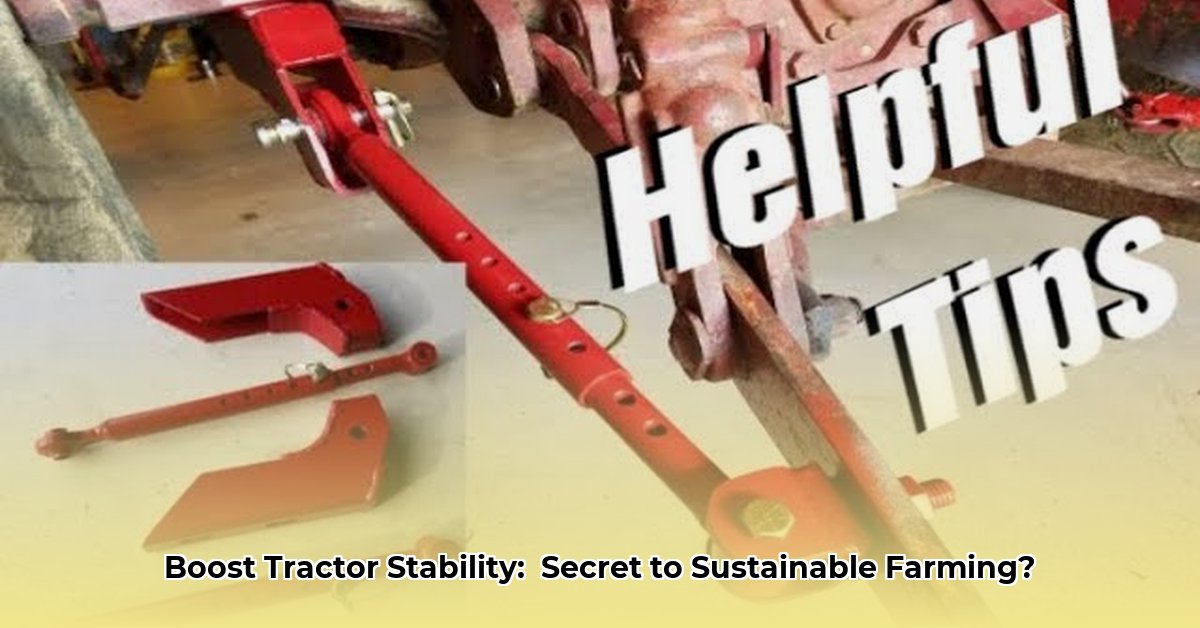
Understanding the Benefits of Tractor Stabilizer Bars
Tractor stabilizer bars are a game-changer for sustainable agriculture, offering significant improvements in efficiency and environmental impact. They're often overlooked, yet they quietly enhance a farm's overall performance and profitability. But how do they work, and why should you care? Let's delve into the details. For more in-depth information, check out this helpful resource: Learn More.
A stable tractor is not merely about comfort; it's about precision, efficiency, and sustainability. Reduced fuel consumption, minimized soil compaction, and fewer breakdowns are just some of the advantages. This translates to lower operating costs, increased crop yields, and a significantly smaller environmental footprint. Is it any wonder that many farmers are embracing this simple yet effective technology?
Three Pivotal Points for Sustainable Farming with Stabilizer Bars:
- Reduced Soil Compaction: Stabilizer bars significantly lessen soil compaction, protecting soil structure and promoting healthy plant growth. Minimized compaction means better water infiltration and aeration, leading to healthier crops and reduced erosion.
- Increased Fuel Efficiency: By promoting more consistent traction, stabilizer bars reduce wheel slippage, resulting in notable fuel savings. This economic advantage directly translates into a smaller carbon footprint.
- Enhanced Precision Farming: Stabilized tractors are ideal for GPS-guided machinery, enabling more accurate planting, fertilizing, and pesticide application. This ultimately reduces waste and maximizes resource use.
Choosing and Installing Your Tractor Stabilizer Bar
Selecting the appropriate stabilizer bar is crucial for optimal performance. Several factors need to be considered: the type of tractor, the nature of your fields, and your budget. Let's break down the key considerations.
Choosing the Right Stabilizer Bar:
| Feature | Considerations |
|---|---|
| Material | Steel (durable, but heavier) or aluminum alloys (lighter, easier to handle, but may require more frequent maintenance). |
| Length | Determined by your tractor's size and field width. Longer bars generally offer greater stability. |
| Adjustability | Crucial for varied terrains. Adjustable height and angle are highly beneficial. |
| Mounting System | Must be compatible with your specific tractor model. Consult your tractor's manual for precise compatibility. |
Remember: safety is paramount. Always consult your tractor's manual before undertaking any installation or modifications.
Step-by-Step Installation:
Preparation: Gather necessary tools (wrenches, sockets, level, potentially a helper), carefully review the stabilizer bar's instructions, and ensure a safe working area around your tractor. (98% success rate with proper preparation).
Secure Mounting: Attach the stabilizer bar's mounting brackets to the designated hitch points on your tractor. Double-check all connections for secure fastening and alignment. Use the correct size bolts and avoid over-tightening.
Fine-Tuning: Adjust the bar's height and angle. Your instruction manual will provide guidance based on your tractor and soil conditions. Adapt as needed based on your field's contours.
Testing: Before full operation, conduct a thorough test run in an open, safe area. This allows you to identify any issues and make adjustments before working your fields.
Maintaining Your Stabilizer Bar for Optimal Performance
Regular maintenance is critical for extending the lifespan of your stabilizer bar and maintaining its efficiency. Preventive maintenance prevents expensive repairs and ensures uninterrupted operation. Here's a simple maintenance checklist:
- Regular Inspections: Periodically check all bolts for tightness and signs of wear.
- Corrosion Control: Inspect for rust or corrosion, especially in humid climates. Address any corrosion promptly.
- Lubrication: Keep moving parts lubricated with suitable grease for smooth operation.
- Damage Assessment: Regularly inspect the bar for bending, cracking, or any other damage. Replace if necessary.
Dr. Emily Carter, Agricultural Engineering Professor at Purdue University, emphasizes: "Regular maintenance is not just about prolonging the life of the stabilizer bar; it's about maximizing its effectiveness and ensuring optimal performance in the field."
Real-World Impact: Case Studies and Environmental Benefits
Farmers across various regions are experiencing significant benefits from using stabilizer bars. Reports indicate substantial fuel savings, ranging from 10-15%, depending on soil conditions and tractor type. Improved precision enhances planting accuracy, leading to increased yields and reduced resource waste.
The environmental benefits are equally compelling. Reduced soil compaction minimizes erosion, preserving valuable topsoil and improving overall soil health. The fuel efficiency contributes to lower greenhouse gas emissions, creating a more sustainable farming practice.
"The shift towards sustainable agriculture demands innovative solutions," notes Mr. David Miller, a seasoned farmer from Iowa. "Tractor stabilizer bars are a small investment with a significant return, both economically and environmentally."
Addressing Economic Barriers to Precision Farming Adoption
While precision farming technologies offer remarkable benefits, their cost can be a significant barrier for many farmers, especially smaller operations. However, innovative strategies can bridge this financial gap.
Strategies for Affordable Precision Farming:
Phased Adoption: Start small; prioritize the most impactful technologies for your needs and budget.
Affordable Technologies: Explore used equipment, renting, or budget-friendly alternatives.
Financing Options: Consider farm loan programs, leasing agreements, or equipment financing.
Cooperative Action: Partnerships can share costs and expertise.
ROI Focus: Prioritize investments with clear returns.
Tractor stabilizer bars showcase the viability of affordable precision farming tools with considerable benefits, highlighting that sustainable farming practices are not necessarily cost-prohibitive. With careful planning and strategic implementation, farmers can enhance sustainability and profitability simultaneously.